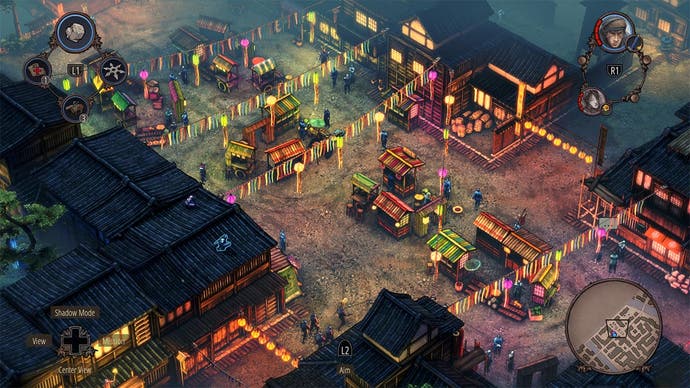Shadow Tactics: Blades of the Shogun review
Ronin errands.
There's not much more satisfying than seeing a good team come together, something Shadow Tactics developer Mimimi no doubt understands. Shadow Tactics is a strategy/stealth hybrid set in feudal Japan that follows in the footsteps of the long lost but fondly remembered Commandos games.
Players issue commands to five different characters, each with their own unique talents. Your bulky samurai can slay three opponents clustered together and carry two cadavers at once, your elderly peg-legged sniper whittles away the opposition from afar, your crafty orphan plants traps, your all-rounder soldier throws a mean shuriken, and your seductress gets dolled up in disguises to distract guards. Each hero is fairly limited on their own, but together they form quite the team.
As a result, Shadow Tactics doesn't feel like anything else out there. It's slower and more meticulous than most stealth games where you control a single entity, its real-time action sets it apart from any number of turn-based strategy affairs, and the laser focus on a tiny but talented crackerjack team feels worlds away from a typical RTS with its many moving gears colliding in all-out war. The merging of mechanics resembles the unholy spawn of Hotline Miami, The Lost Vikings, and Splinter Cell.
It's a winning combination that offers a unique blend of puzzles, action, and experimentation - with an emphasis on experimentation. Unlike most stealth or strategy games, Shadow Tactics is designed to make you fail to a ludicrous degree. A shame, then, that the consequence for failure can be so harsh. Every time you're caught throngs of guards swarm the stage, punishing imprecision at the drop of a hat. Unlike most modern stealth games where things arguably get more exciting once you've messed up, Shadow Tactics opts for a more ruthless approach. More often than not, once enemies open fire the jig is up. Failure's part of the process, something to be endured rather than seen through.
This focus on defeat works because when a plan eventually comes together it feels great. This happens most in what's called Master Mode, a feature wherein you can issue commands to each character that's only to be executed when you give the signal. Chances are your timing or positioning will be off and some component of the plan will fail, but when every piece of scripting hits its mark and your ragtag crew of bandits Mission Impossibles their way through a fortified fortress, simultaneously stabbing, blinding, and distracting guards, there's nothing quite like it. You didn't just solve a puzzle, you choreographed a clean, classy heist, you criminal mastermind you.
It's a shame then that much of the game can be conquered without calling upon your wits. For the most part, you can thin out the herd by resorting to the same handful of basic tactics that you learn in the beginning. The first time one character creates a diversion while the other two stab guards in the back, it feels fantastic. But by the 50th time, it loses a bit of its lustre. It's hard to say if that's the game's fault or my own for not being cunning enough to orchestrate more creative plans, but many of Shadow Tactics' challenges can be bested by playing in the dullest, most conservative way.

This doesn't ruin Shadow Tactics, but it does make it rather monotonous at times. There are too many banal, brute force solutions to Shadow Tactics' challenges, and unless you're going for all the game's optional badges, there's not much incentive to deviate from the boring but effective solutions. I suspect high level players will have to get fairly canny to conquer Shadow Tactics' most devious challenges, but on an initial playthrough there are too many bland sections where it's overly tempting to simply stick with what you know.
Perhaps the biggest missed trick here is that Master Mode, lovely and exciting as it is, only allows you to issue one command to each teammate. In other words, you can tell your squadmates to kill a guard, but not to retreat to cover after the fact. Having to manually move everyone to safety afterwards is both an inconvenient chore and an irritating, artificial restriction on the types of assaults available. Perhaps being able to preemptively issue commands to kill then hide would shift the difficulty setting too much, but it would go a long way towards putting Shadow Tactics' best feature on centre stage.

As is, Shadow Tactics' biggest problem is the amount of drudgery involved in executing a plan. Part of this is due to the fact that this is a console port of a game designed with a mouse and keyboard in mind, but much of it simply seems awkwardly dragged out. To wit: there's no way to undo one squad command in Master Mode without forfeiting the whole plan and having to manually reassign each order. The game feels like setting up dominos then cathartically knocking them over, which is how a tactics game should feel, but it would be nice if the dominoes were a little less cumbersome to set up.
Shadow Tactics has a lovely premise and a lot of clever puzzles, but a few irritating design decisions hold it back from truly being the ultimate team-based infiltration game it so wants to be. It's almost there though. Bringing back such a genre hybrid in this day and age - and on consoles no less - is still cause for celebration. Shadow Tactics is a little too long in the tooth to stay fresh during the entirety of its two dozen hour campaign, but it hits notes other games don't. In an age where every AAA stealth game is gradually turning into a homogenous pool of third-person cover-cowering vent-crawling affairs, Shadow Tactics is on an invigoratingly different trajectory. Mimimi's attempt to resurrect this style of game isn't quite the flawless masterplan that goes off without a hitch, but it's still a refreshing refinement of a long lost art.





